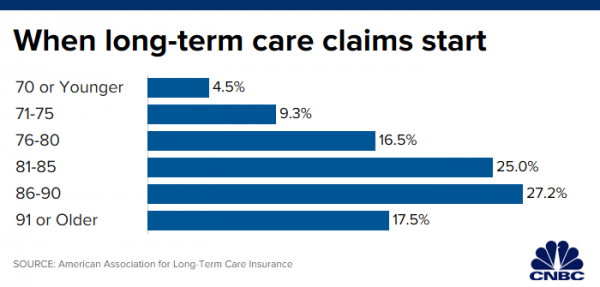"Not having long-term care insurance can be ‘the single biggest devastator’ of your financial plan" CNBC, October 15, 2019
How can a Home Equity Conversion Mortgage (HECM) Line of Credit help pay Long-Term Care expenses?
There’s a 70% chance that people over 65 will need some kind of long-term care, including services such as home care, assisted living and skilled nursing, according to government statistics.

Unfortunately, many seniors believe that Medicare will cover their home care needs when in fact, Medicare pays $0 for long-term care services after 100 days.
There are lots of ways to pay for long-term care services, including Medicaid, long-term care insurance, hybrid life insurance policies and annuities. Some people may have access to funding via the Older Americans Act and the Department of Veterans Affairs.
There’s an additional option worth exploring: a Home Equity Conversion Mortgage (HECM) Line of Credit, in which you can withdraw cash from the equity you have built up in your home.
Access to your home’s equity
Most reverse mortgages involve a lump sum for an immediate need or a string of payments over time to use a certain percentage of home equity to fund a need. Because reverse mortgages are generally used by older people whose homes are paid off or nearly paid off, long-term care is one natural use of the funds.
Since 1989, the U.S. Department of Housing and Urban Development has worked with private lenders to administer what are officially called Home Equity Conversion Mortgages, commonly called reverse mortgages. Several modifications over the years have added more features and programs to help homeowners 62 or older access a portion of their home equity.
One of the options under this program is a HECM Line of Credit that increases in value each year as long as the owner doesn’t use it. Here’s an example:
Let’s say you’re 65. You don’t need long-term care now, but you want the security of knowing it will be there when and if you need it. You could, for example, get a $219,000 HECM Line of Credit that increases in value around 4% per year (or whatever the interest rate is on the loan’s anniversary) no matter what happens to the value of your $450,000.
When you reach 85 and your need to pay for long-term care could be reaching a high point, the Line of Credit amount would have grown to roughly $540,000.
As you use this available money, you don’t have to pay a monthly bill as you would with traditional home equity loans; the money is just subtracted from the equity in the home. The Line of Credit comes due either when you move out of your home or die, in which case your heirs or your estate could pay the loan back either through sale of the home or other means. If you never used the Line of Credit, the equity would still be in place and would pass to heirs along with the home.
Advantages over a Home Equity Line of Credit (HELOC)
A HECM Line of Credit holds some advantages over a home equity line of credit, a similar concept in which a homeowner can borrow against the equity in the home. With a HELOC, the borrower must begin making monthly payments immediately and this type of loan is not permanent. With a HECM Line of Credit, the borrower doesn’t have to make monthly payments at all.
And, as indicated above, the available funds in this type of line of credit grow over time, while HELOCs typically provide a fixed amount that the borrower can draw against and that the lender could freeze at any time to preclude further borrowing.
You can think of this type of reverse mortgage as an old-age insurance vehicle. Of course, it’s not insurance, but it’s an opportunity to have another source for funding long-term care services if Social Security, pensions and savings can’t cover the cost of care.
For additional information
Should you use a reverse mortgage to pay for long-term care?
Associated Press, Kate Ashford of NerdWallet, June 1, 2022
Does Medicare Pay For Long-Term Care? Don’t Make A Big Mistake!
Forbes, Diane Omdahl, January 27, 2020
These advisors help their clients tackle this unknown looming cost
CNBC, Sarah O'Brien, November 15, 2019


